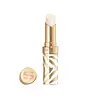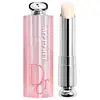What's inside
What's inside
 Key Ingredients
Key Ingredients

 Benefits
Benefits

 Concerns
Concerns

 Ingredients Side-by-side
Ingredients Side-by-side

Polybutene
Caprylic/Capric Triglyceride
MaskingPolyethylene
AbrasiveDicalcium Phosphate
AbrasiveMicrocrystalline Wax
Emulsion StabilisingEthylhexyl Palmitate
EmollientButylene Glycol
HumectantButyrospermum Parkii Butter
Skin ConditioningTocopheryl Acetate
AntioxidantSodium Hyaluronate
HumectantPadina Pavonica Thallus Extract
Skin ConditioningGlucomannan
Skin ConditioningStearalkonium Hectorite
Gel FormingMica
Cosmetic ColorantCitric Acid
BufferingPropylene Carbonate
SolventSimmondsia Chinensis Seed Oil
EmollientTrihydroxystearin
Skin ConditioningTin Oxide
AbrasiveEthyl Vanillin
MaskingParfum
MaskingPentaerythrityl Tetra-Di-T-Butyl Hydroxyhydrocinnamate
AntioxidantCI 77891
Cosmetic ColorantIron Oxides
CI 42090
Cosmetic ColorantCI 15850
Cosmetic ColorantCI 45410
Cosmetic ColorantCI 15985
Cosmetic ColorantCI 19140
Cosmetic ColorantPolybutene, Caprylic/Capric Triglyceride, Polyethylene, Dicalcium Phosphate, Microcrystalline Wax, Ethylhexyl Palmitate, Butylene Glycol, Butyrospermum Parkii Butter, Tocopheryl Acetate, Sodium Hyaluronate, Padina Pavonica Thallus Extract, Glucomannan, Stearalkonium Hectorite, Mica, Citric Acid, Propylene Carbonate, Simmondsia Chinensis Seed Oil, Trihydroxystearin, Tin Oxide, Ethyl Vanillin, Parfum, Pentaerythrityl Tetra-Di-T-Butyl Hydroxyhydrocinnamate, CI 77891, Iron Oxides, CI 42090, CI 15850, CI 45410, CI 15985, CI 19140
Polyglyceryl-2 Triisostearate
EmulsifyingHelianthus Annuus Seed Oil
EmollientHydrogenated Castor Oil Dimer Dilinoleate
Skin ConditioningPhytosteryl/Octyldodecyl Lauroyl Glutamate
Skin ConditioningJojoba Esters
EmollientPolyglyceryl-2 Isostearate/Dimer Dilinoleate Copolymer
EmollientEuphorbia Cerifera Wax
Behenyl Behenate
EmollientHelianthus Annuus Seed Wax
Skin ConditioningButyrospermum Parkii Butter
Skin ConditioningOryza Sativa Bran Wax
Skin ConditioningCaprylic/Capric Triglyceride
MaskingParfum
MaskingTrimethylolpropane Triisostearate
EmollientDiisostearyl Malate
EmollientButyrospermum Parkii Butter Unsaponifiables
Skin ConditioningPrunus Avium Seed Oil
EmollientTocopherol
AntioxidantEthyl Vanillin
MaskingAscorbyl Palmitate
AntioxidantUndaria Pinnatifida Extract
Skin ConditioningPropyl Gallate
AntioxidantCI 15850
Cosmetic ColorantCI 15985
Cosmetic ColorantCI 19140
Cosmetic ColorantCI 42090
Cosmetic ColorantCI 45410
Cosmetic ColorantCI 45380
Cosmetic ColorantCI 73360
Cosmetic ColorantCI 77491
Cosmetic ColorantCI 77492
Cosmetic ColorantCI 77499
Cosmetic ColorantCI 77891
Cosmetic ColorantPolyglyceryl-2 Triisostearate, Helianthus Annuus Seed Oil, Hydrogenated Castor Oil Dimer Dilinoleate, Phytosteryl/Octyldodecyl Lauroyl Glutamate, Jojoba Esters, Polyglyceryl-2 Isostearate/Dimer Dilinoleate Copolymer, Euphorbia Cerifera Wax, Behenyl Behenate, Helianthus Annuus Seed Wax, Butyrospermum Parkii Butter, Oryza Sativa Bran Wax, Caprylic/Capric Triglyceride, Parfum, Trimethylolpropane Triisostearate, Diisostearyl Malate, Butyrospermum Parkii Butter Unsaponifiables, Prunus Avium Seed Oil, Tocopherol, Ethyl Vanillin, Ascorbyl Palmitate, Undaria Pinnatifida Extract, Propyl Gallate, CI 15850, CI 15985, CI 19140, CI 42090, CI 45410, CI 45380, CI 73360, CI 77491, CI 77492, CI 77499, CI 77891
 Reviews
Reviews

Ingredients Explained
These ingredients are found in both products.
Ingredients higher up in an ingredient list are typically present in a larger amount.
This ingredient is also known as shea butter. It is an effective skin hydrator and emollient.
Emollients help soothe and soften your skin. It does this by creating a protective film on your skin. This barrier helps trap moisture and keeps your skin hydrated. Emollients may be effective at treating dry or itchy skin.
Shea butter is rich in antioxidants. Antioxidants help fight free-radicals, or molecules that may harm the body. It is also full of fatty acids including stearic acid and linoleic acid. These acids help replenish the skin and keep skin moisturized.
While Shea Butter has an SPF rating of about 3-4, it is not a sunscreen replacement.
Shea butter may not be fungal acne safe. We recommend speaking with a professional if you have any concerns.
Learn more about Butyrospermum Parkii ButterThis ingredient is an emollient, solvent, and texture enhancer. It is considered a skin-softener by helping the skin prevent moisture loss.
It helps thicken a product's formula and makes it easier to spread by dissolving clumping compounds.
Caprylic Triglyceride is made by combining glycerin with coconut oil, forming a clear liquid.
While there is an assumption Caprylic Triglyceride can clog pores due to it being derived from coconut oil, there is no research supporting this.
Learn more about Caprylic/Capric TriglycerideCi 15850 is the pigment color red. It is an azo dye and created synthetically.
Azo dyes need to be thoroughly purified before use. This allows them to be more stable and longer-lasting.
This ingredient is common in foundations, lipsticks, and blushes. This color is described as brown/orangey red.
It has many secondary names such as Red 6 and Red 7. According to a manufacturer, Red 6 usually contains aluminum.
Learn more about CI 15850Ci 15985 is a dye made from petroleum. It is synthetically created and approved by the FDA for use in foods and cosmetics.
The color of this dye is orange/yellow.
This ingredient can be found in makeup, sun care, and skincare.
Learn more about CI 15985CI 19140 is also known as Tartrazine. Tartrazine is a synthetic dye used in cosmetics, foods, and medicine to add a yellow color.
Tartrazine is created from petroleum and is water-soluble.
Some people may experience allergies from this dye, especially asthmatics and those with an aspirin intolerance.
Learn more about CI 19140Ci 42090 is a synthetic dye created from petroleum. It is used to give a bright blue color to cosmetics, medicine, and food.
CI 45410 is a synthetic red-pigment and dye.
It often goes by both Red 28 or Red 27; manufacturers label both ingredients as CI 45410.
This dye is commonly found in makeup because it imparts a vivid color. Some types of this dye change color based on pH level and interaction with moisture:
Your skin has a natural pH of around 4.5 - 5.5.
According to the FDA, CI 45410 is not permitted for use in eye products.
Red 27 is a flourescein dye and commonly used as a fluorescent tracer in medicine.
Learn more about CI 45410Ci 77891 is a white pigment from Titanium dioxide. It is naturally found in minerals such as rutile and ilmenite.
It's main function is to add a white color to cosmetics. It can also be mixed with other colors to create different shades.
Ci 77891 is commonly found in sunscreens due to its ability to block UV rays.
Learn more about CI 77891We don't have a description for Ethyl Vanillin yet.
Parfum is a catch-all term for an ingredient or more that is used to give a scent to products.
Also called "fragrance", this ingredient can be a blend of hundreds of chemicals or plant oils. This means every product with "fragrance" or "parfum" in the ingredients list is a different mixture.
For instance, Habanolide is a proprietary trade name for a specific aroma chemical. When used as a fragrance ingredient in cosmetics, most aroma chemicals fall under the broad labeling category of “FRAGRANCE” or “PARFUM” according to EU and US regulations.
The term 'parfum' or 'fragrance' is not regulated in many countries. In many cases, it is up to the brand to define this term.
For instance, many brands choose to label themselves as "fragrance-free" because they are not using synthetic fragrances. However, their products may still contain ingredients such as essential oils that are considered a fragrance by INCI standards.
One example is Calendula flower extract. Calendula is an essential oil that still imparts a scent or 'fragrance'.
Depending on the blend, the ingredients in the mixture can cause allergies and sensitivities on the skin. Some ingredients that are known EU allergens include linalool and citronellol.
Parfum can also be used to mask or cover an unpleasant scent.
The bottom line is: not all fragrances/parfum/ingredients are created equally. If you are worried about fragrances, we recommend taking a closer look at an ingredient. And of course, we always recommend speaking with a professional.
Learn more about Parfum